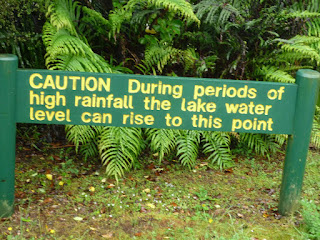THE WEST COAST: 16/12 - 20/12
After we left Queenstown we travelled North, in lovely weather, to lake Wanaka, which is like Queenstown on a smaller scale with lots of water-borne and mountain activities along with beautiful scenery. However the next morning there was low cloud and rain and, since we could not see the scenery, we decided to continue our journey to the West coast and northwards. There is little we can tell you about the scenery on the West coast as we did not see anything beyond the road for 4 or 5 days owing to the rain and low cloud coming in from the Tasman Sea.
What we do know is that it is an area of sub-tropical rain forest and that lichen grows on everything from trees to fence posts.
An example of the lichen that grows on every thing that does not move.
One extraordinary feature we were aware of was how sub-tropical rain forest can grow on near vertical rock faces without the trees falling off. It all starts with the lichen which grows on the rock face and then, when there is a thick covering, saplings start to grow and interweave their roots so that over a long period of time a strong base is formed for trees to grow. (This is pretty boring stuff but reflects how boring it can be driving in heavy rain and mist for 4 days!)

This sign was a few feet away from our van when we camped beside Lake Paringa. The water was nowhere near it so we reckoned we would be OK, however.....
the view from the rear window of the van the next morning showed the well defined bank had disappeared and lake had advanced significantly.
The name and motto of the bar in a camp site near the Franz Joseph glacier indicate that rain is not unusual in those parts.
The Franz Joseph glacier is a 'must see' and is one of the few advancing glaciers remaining in the world. However there is a 2 mile walk to the face of the glacier from the nearest car park and the rain was torrential.
Fran has just discovered that putting a water resistant jacket in the washing machine destroys the water resistant properties.
This is a close as you can get to the face without a guide. The fellow telling me to stop is actually a cardboard cut-out.
The intrepid explorer returns to the van in a jacket which had long since given up all resistance to the rain.
Rather bedraggled tributes to the Pike River miners.
The so called 'pancake rocks' on the coast at Punakaiki. The way in which they have weathered is supposed to make them look like piles of pancakes, which says a lot about New Zealand food!
Our first Christmas decoration! He had travelled with us from the UK as a gift from Georgie and Olivia.
In pride of place in the cab.
NELSON/PICKTON 20/12 - 22/12
Nelson is a seaside resort and not particularly remarkable apart from the fact that the sun began to shine for us again there.
We were able to use the bikes again.
Dr Doolittle is at it again.
The port at Picton with 2 inter-island ferries preparing to depart for the North Island.
Well on our way down Queen Charlotte Sound which is spectacularly beautiful, and is not just a means to an end in travelling between the islands but stands alone as one of the things that should be seen in NZ.
This is the entrance to Queen Charlotte Sound, or in this case the exit to the Cook Strait. It is incredibly narrow for large ships and marks the end of the calm waters and light winds of the Sound. There were gale force winds and very rough seas in the Strait.















No comments:
Post a Comment